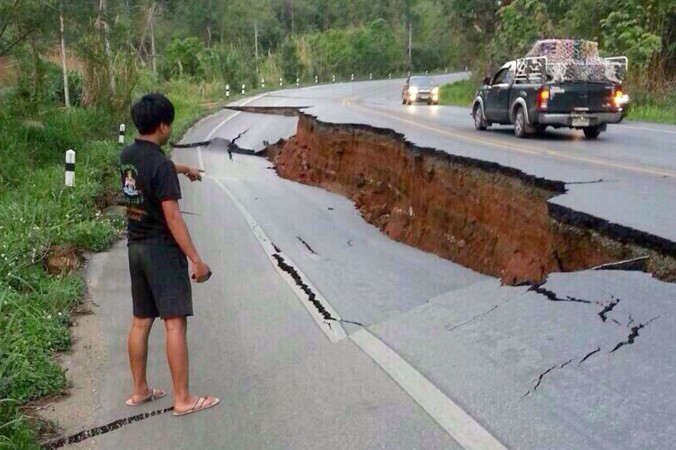Earthquake in Thailand and Burma[/b]

A strong earthquake shook northern Thailand and Burma on Monday evening, smashing windows, cracking walls and roads and damaging Buddhist temples. No casualties have been reported.
The airport in Chiang Rai, a northern Thai city near the epicenter of the 6.0-magnitude temblor, evacuated its terminal, where display signs and pieces of the ceiling fell. No one was hurt and there was no damage to the runway or flight disruptions, airport General Manager Damrong Klongakara said. The terminal and its roof were still being checked for further damage. A well-known temple in the city, Wat Rongkhun, was closed due to safety concerns after the earthquake.
The spire of the main building came off and the tiles on the roof fell off, Chalermchai Kositpiphat, the artist who built the temple, told Nation TV. I still don’t know how we can sleep tonight. It was shaking the whole time and then aftershocks followed four to five times. It will bring more damages each time an aftershock happens, I’m afraid. The murals are also damaged because the pillars were shaken badly, Chalermchai said. I don’t know how many years it will take me to fix it. It was tumbling like the Earth was going to explode. The head of a Buddha statue fell at the Udomwaree Temple in Chiang Rai, according to monk Phra Pathompong. A residential building at the temple also had exterior cracks and ceiling damage, and nearby residents reported only minor damage in their homes, he said. Damages were being assessed in Chiang Rai’s Phan district, where ceilings fell in some homes, said Wander Radchompoo, head of the district. A damaged road in the district had multiple cracks, the worst a waist-high gash about the length of three vehicles.
People ran down stairs in office buildings in Burma’s largest city, Yangon, and severe shaking also was felt in Chiang Mai, Thailand’s second-largest city. Window curtains briefly swayed in the Thai capital, Bangkok. (Burma was officially renamed Myanmar after a 1962 military coup.) The U.S. Geological Survey said the epicenter was 9 kilometers (6 miles) south of Mae Lao, Thailand, and 27 kilometers (17 miles) southwest of Chiang Rai. Its depth was a relatively shallow 7.4 kilometers (4.6 miles). Shallow quakes are generally felt more widely.
The U.S. Geological Survey said the epicenter was 9 kilometers south of Mae Lao, Thailand, and 27 kilometers southwest of Chiang Rai. Shaking was felt in Bangkok, 800 kilometers south of Chiang Rai. The quake occurred at a relatively shallow depth of 7.4 kilometers. Shallow quakes are generally felt more widely.

A strong earthquake shook northern Thailand and Burma on Monday evening, smashing windows, cracking walls and roads and damaging Buddhist temples. No casualties have been reported.
The airport in Chiang Rai, a northern Thai city near the epicenter of the 6.0-magnitude temblor, evacuated its terminal, where display signs and pieces of the ceiling fell. No one was hurt and there was no damage to the runway or flight disruptions, airport General Manager Damrong Klongakara said. The terminal and its roof were still being checked for further damage. A well-known temple in the city, Wat Rongkhun, was closed due to safety concerns after the earthquake.
The spire of the main building came off and the tiles on the roof fell off, Chalermchai Kositpiphat, the artist who built the temple, told Nation TV. I still don’t know how we can sleep tonight. It was shaking the whole time and then aftershocks followed four to five times. It will bring more damages each time an aftershock happens, I’m afraid. The murals are also damaged because the pillars were shaken badly, Chalermchai said. I don’t know how many years it will take me to fix it. It was tumbling like the Earth was going to explode. The head of a Buddha statue fell at the Udomwaree Temple in Chiang Rai, according to monk Phra Pathompong. A residential building at the temple also had exterior cracks and ceiling damage, and nearby residents reported only minor damage in their homes, he said. Damages were being assessed in Chiang Rai’s Phan district, where ceilings fell in some homes, said Wander Radchompoo, head of the district. A damaged road in the district had multiple cracks, the worst a waist-high gash about the length of three vehicles.
People ran down stairs in office buildings in Burma’s largest city, Yangon, and severe shaking also was felt in Chiang Mai, Thailand’s second-largest city. Window curtains briefly swayed in the Thai capital, Bangkok. (Burma was officially renamed Myanmar after a 1962 military coup.) The U.S. Geological Survey said the epicenter was 9 kilometers (6 miles) south of Mae Lao, Thailand, and 27 kilometers (17 miles) southwest of Chiang Rai. Its depth was a relatively shallow 7.4 kilometers (4.6 miles). Shallow quakes are generally felt more widely.
The U.S. Geological Survey said the epicenter was 9 kilometers south of Mae Lao, Thailand, and 27 kilometers southwest of Chiang Rai. Shaking was felt in Bangkok, 800 kilometers south of Chiang Rai. The quake occurred at a relatively shallow depth of 7.4 kilometers. Shallow quakes are generally felt more widely.
